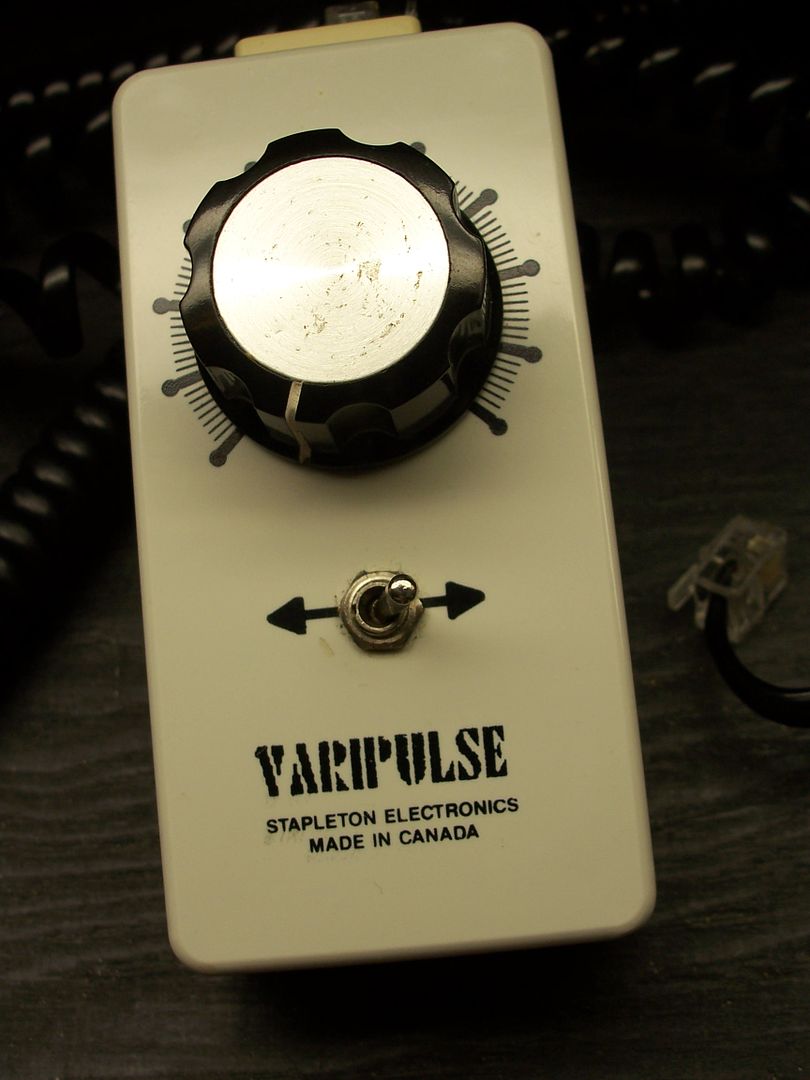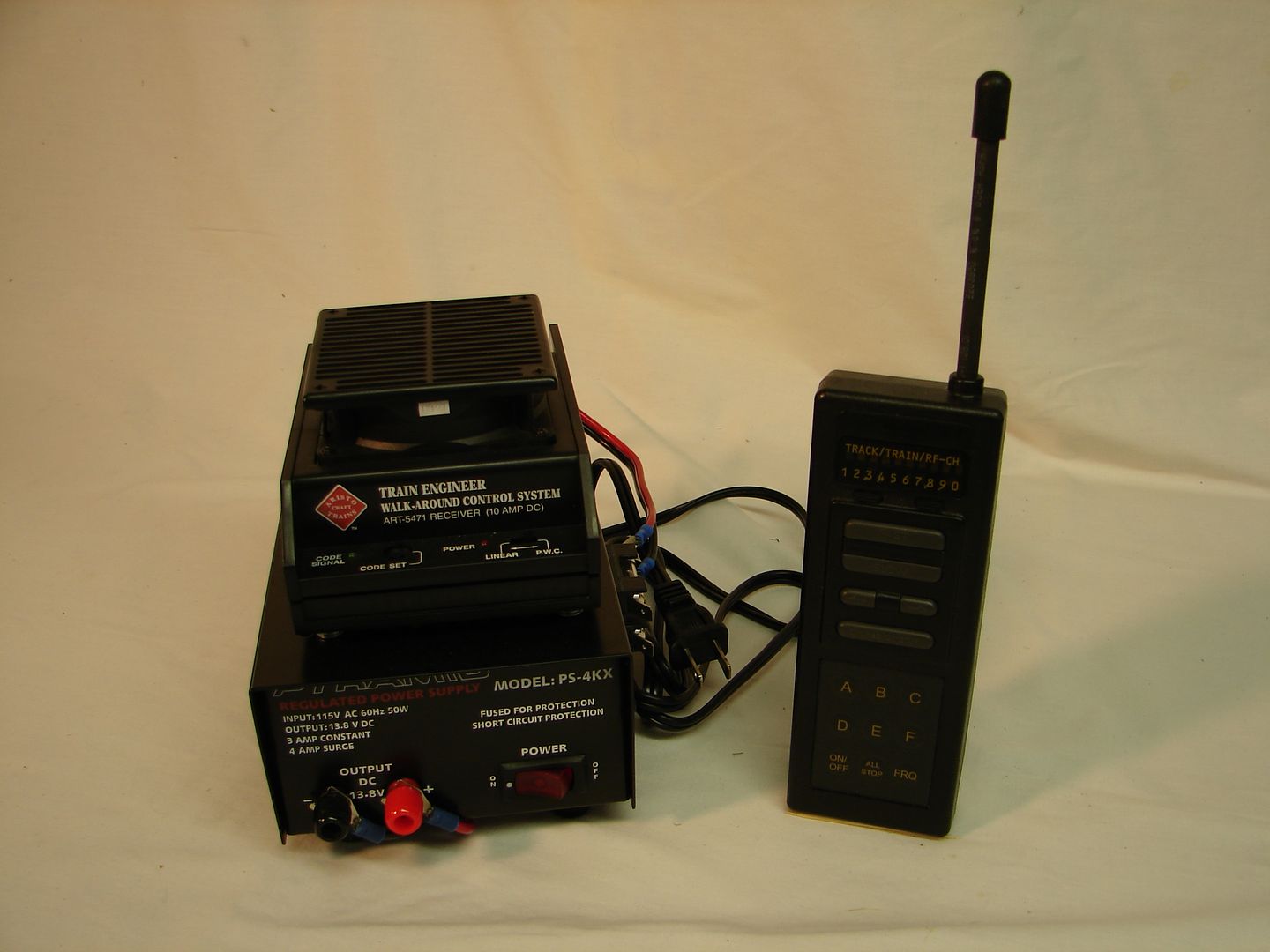I bought off of eBay back in August my MRC Master Control 20 Walk Around Throttle for analog DC operations. It is the most powerful DC unit on the market to date. After a few months, the handheld is not working properly. It refuses to activiate when power is applied. The base unit is working fine. The phone jacks also work. Anybody else have similar issues and any fixes to this?
Did you try a different connecting cable?
Does the “power monitor” light light up on the main console?
Ed
I have the same set-up, but wasn’t overly impressed by the handheld throttle, which doesn’t offer much finesse in speed adjustments, so replaced it with this one, from Ken Stapleton Electronics…

It has Pulse Width Modulation, which offers great speed control (there’s an adjustable screw on the handheld that can vary the starting voltage), and can handle multiple locomotives if you’re running long or heavy trains, or, like me, have a layout with lots of grades. I’ve had mine for ages.
I believe that Ken has created some more powerful ones since I bought mine, but can no longer find his website.
If I can find his contact info, I’ll post it here.
Below is the description of the throttle:
1MODEL 821A PWM MODEL RAILROAD THROTTLEThe model 821A PWM model railroad throttle has been designed for use with any scale DC model railroad system. Like it’s predecessor the model 820, this throttle has been designed to provide unparalleled performance in both switching and mainline usage. It is easily installed and requires no maintenance. Please follow these instructions for installation and modifications to
You don’t say if you also have the paperwork.
The link to that is:
https://www.modelrectifier.com/v/vspfiles/resources/dc-ac/Control%20Master%2020%20AA444.pdf
The handheld unit doesn’t deliver any power to the locomotive. That all comes from the powerpack itself. That explains why the handheld can be unplugged and moved to another input jack and the locomotive keeps running.
I deduce the handheld unit signals a receiver in the powerpack to control output voltage and polarity. Momentum would also be affected by the signal.
To the OP: Since you started this thread with the same query as you posted in the 12-year old thread, I deleted those posts and included John’s (PRR 8259) response below. That keeps the replies in one thread rather than two…
CRSR2008–
Did you check the plugs and/or your wiring? Sometimes the length of wire run can be enough to make a power supply not work…just saw that with my dcc system when a friend made a new cable for me. It was too long and had too much resistance. As soon as we went back to the regular cord length we were fine.
FYI - for anyone even contemplating a switch to DCC at some point in the future, the various manufacturers have warnings regarding earlier MRC power supplies VOIDING their warranty on electronics. In at least one case, the manufacturer specifically says not to use any MRC power supply at all, and in other cases, companies such as Rapido tell you specifically which power supplies are the ones that you cannot use (typically the older ones as they do not supply “pure” filtered DC current).
One work around is to install a DPDT toggle switch which will allow you to change from DC operation to DCC operation with a throw of the switch. You can only use one mode at a time, but for those in transition between DC and DCC, this method allows you to retain all those old plain DC units for as long as you want to.
The ONLY MRC power supply that I would consider using with current DCC locomotives would be the MRC Tech 7 and possibly the Tech 6 Sound Controller. The older ones are at this point not recommended to use with current generation DCC locomotives as in some cases they can fry decoders. Even some plain DC engines are using decoders now if only just to control lighting features, etc.
After for years being in the “dc only” crowd, I have basically switched to DCC for all the lighting features, etc. and the current diesel sounds which are much improve
It’s interesting to me that this MRC product does not run the full output power through the hand-held throttle, which is why you can use phone cable as the connection.
It’s a puzzlement as to why they don’t convert the hand-held to radio.
Then DC people could have a cordless walk-around throttle.
Ed
The product is now 20 years old.
Heres the thread about the unit when it was still sort of current:
Hello,
I have actual experience with the MRC CM20, and I have experienced your problem.
When my friend Randy built his N scale layout, beginning back in 1991, at some point he decided to convert it to walk-around control.
Since I did all the wiring on the layout, I did the install. He bought three of the MRC Controlmaster 20s, and the installation was pretty straight-forward.
After less than a year, two of them became problematic. Eventually one failed completely, and the only good one lost low-speed control.
The fix was to throw the MRC controllers into the trash and replace them with Star-Tec Hoggers. Randy bought four of the Hoggers, and the installation was nearly like-for-like. The fourth unit was to convert the yard cab to hand-held.
These have been in service for more than 20 years on the layout, and still are all functioning just fine.
They are not manufactured anymore, but hopefully a good one is not too hard to find.
They do make a terrible noise at power-on, and they hum, But… they work, and keep on working.

-Kevin
Mrc was once the go to power pack but I have seen so many of them fail. Only have one that still works which supplys the AC to my turntable.
Hi Ed. Yes I tried a different phone cord-nothing. The base unit is getting power as when I engage the handheld, the signal is getting to it. The power light responses to throttle position, the directional works as well as the momentum. I discovered (strangely) that the problem fixed itself after a day or two.
Thanks Wayne for all the great information. I have heard of this type and that it is a kit only project. I suck at electronic building (LOL). As to my problem it seem to have fixed itself. I never discovered why it was giving me problems.
I downloaded the MRC paperwork once I got the unit. Thanks. The problem seem to have fixed itself.
Hi John. Thanks for your help. I do have a heavy duty DPDT toggle that I installed to go from analog DC to DCC. I checked the wiring and connections to see if the wires were touching - nothing there. I use the standard coil plug in that came with the unit and installed three phone jacks. They all work. I thought about the power issues and think that running four locomotives at a time closes to the source might have been the problem. I like to make power moves at my engine facility, which is when the problem started. After a few days, the problem seem to fix itself.
Like DCC, the cable only sends signals for throttle position, direction, and momentum. There is no physical current expect to power the light indicators. That’s what I think. I might be wrong, but this makes sense to me. As for radio, I wonder about that too.
I noticed that MRC products are great for the first two or three years, then they seem to start failing at a fast rate. However, there are some that work as expected for 10 plus years. MRC is being compared to Bachmann: hit or miss products. Why would your friend need more than two MRC or Hogger walkaround units for N-scale? His layout must be huge! Did you wire it with multiple dual plug ports or single ports per area? Why are Hoggers no longer being produced?
I received a reply from Ken this morning. Here’s a LINK to his website.
You can run the circuit board for the Stapleton throttle from either the AC or DC terminals of the ControlMaster 20.
Wayne
Note that he says he’s moving the ‘Web presence’ over to his Classix Audio site:
MRC seems to have completely ignored that market?
But you can find Aristo Train Engineer throttles used like this:

Or you can buy the newer version here:
https://www.revoelectronics.com/
Sheldon